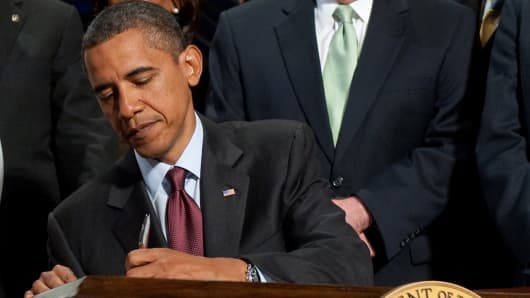It’s been 730 days since President Obama signed the historic Dodd-Frank Wall Street Reform and Consumer Protection Act into law, and while significant progress has been made regarding its implementation, regulators are still facing a staggering number of rules, drafts, and final interpretations that have yet to be determined.
Those include a ban on proprietary trading — known as the Volcker rule — which, because of a peculiar phase-in timeline, becomes effective on Saturday (despite the fact that it has yet to be fully written).
To look at the work Washington still has to do to put a final stamp on Dodd-Frank is mind-numbing in both its volume and complexity.
According to law firm Davis Polk, regulators have written nearly 9,000 pages of rules and regulations based upon the original 848-page bill, and they’re only 30 percent done. If that ‘inflation rate’ stays consistent, the final Dodd-Frank rule-making documents would total roughly 30,000 pages.
The most controversial slice of the law remains the Volcker Rule: A 268-page provision designed to prevent large banks from making outsized, risky bets that are insured by taxpayer-funded bailouts. While the concept is straightforward, it remains the single-biggest sticking point due to complexity of defining key elements of the provision, elements that determine how banks carry out what formerly were basic hedging and market-making practices.
For banks and regulators alike, the major worry remains: Implement the rule in too strict a fashion, and Washington risks an unintended consequence of driving banks out of lines of business critical to markets' liquidity.
Regardless of regulatory limbo, as of Saturday banks will have to comply with the “spirit” of the rule or risk regulatory penalty, according to lawmakers. If they don’t, they could be fined or even undergo management shakeups for any egregious violations.
The key provisions that have been codified so far:
- Banks can’t have prop trading desks.
- They have to limit their stakes in hedge funds to less than 3 percent of the bank’s capital.
- They can’t acquire another company if the resulting combination would have more than 10 percent of the liabilities of the financial system.
We’ve already seen banks comply with these provisions, shutting down prop trading desks and selling stakes in hedge funds they own.
Besides the Volcker rule, rules surrounding derivatives like swaps (widely-used financial instruments that banks can use to hedge risks or bet on certain markets) and various aspects of the mortgage process (including how banks issue home loans and how they’re securitized) also await final implementation.
As Wall Street waits, many investors and analysts are growing uneasy. Bank earnings for the second quarter largely fizzled. The biggest U.S. banks scrambled to cut costs to buoy bottom lines battered by poor macroeconomic conditions and low interest rates. For some critics of the legislation, like CLSA bank analyst Mike Mayo, those results were not helped by uncertainty around the rules.
“The great irony is that regulation should help reduce risk among banks, but uncertainty about regulation itself is impacting bank stocks,” Mayo told CNBC.
To be sure, some banking advisors contend that, for rules with a potential impact this big, the risks of moving too quickly could be exceedingly dangerous.
“I think the regulators are doing exactly what they should do: don’t worry about deadlines, worry about getting it right,” said Thomas Vartanian, chair of the financial institutions practice for law firm Dechert. “In my 35 years in government and Washington, I don’t remember any [dire] consequence for a regulator not meeting a deadline, but there can be serious consequences in the marketplace for not getting the regulation right.”
-By CNBC's Jesse Bergman and Kayla Tausche
@JBergmanCNBC
@KaylaTausche



